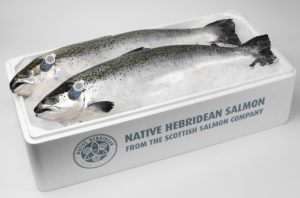Game changers

Bakkafrost has made it clear it is ready to spend big in order to reshape the Scottish Salmon Company.
The Faroese salmon farming group has set aside an investment programme totalling around £180m – or £45m (DKK 400m) a year between now and 2024, which they intend to be a game changer.
The investment programme for the Faroe Islands is estimated at DKK 1.8bn (£207m). A sizeable part of the money for Scotland will be used to fund the building of three large hatcheries to increase smolt capacity so it eventually becomes self-sufficient in providing large smolt. The first of these will be at the company’s existing Applecross hatchery, currently being expanded and equipped with RAS (recirculating aquaculture system) technology. Suitable sites for the next two large hatcheries are still under consideration.
When Bakkafrost acquired the Scottish Salmon Company in October 2019 for around £520m it made it clear that considerable investment would be needed.
The group operates 44 marine sites on the West Coast of Scotland and the Hebridean Islands with 74,765 tonnes of current permitted licence volume. It also owns a unique Native Hebridean broodstock programme producing pure Scottish Island salmon, originally bred from wild stock and farmed only in Hebridean waters. This, says the company, results in a strong, lean and noticeably firmer fish than with other Atlantic salmon.
SSC operates two harvest stations, Arnish Point in the North of Scotland and Ardyne in the south of the country with a total daily capacity of 266 tonnes, along with two processing factories and a smokehouse.
Bakkafrost says the farming situation in Scotland is improving albeit gradually, although the second half of last year was more challenging, especially during the final quarter when SSC suffered exceptionally high mortality rates at some farm sites. Part of that was driven by very severe rainfall in August when Storm Ellen swept through the region causing severe damage to the fish farms of other companies.
The annual report explains: “History has demonstrated that biological challenges in the second half of the year have been a repeating pattern in the Scottish Salmon Company. This pattern is expected to be broken with the transformation of the farming operation that we will be making in the Scottish operation in coming years.
“Challenging third and fourth quarters may be expected for the next couple of years but with gradually reduced severity as the large-smolt strategy is being implemented in the Scottish farming operation.”

Bakkafrost chairman Runi M. Hansen told shareholders: “By increasing the quality and smolt size to 500g the cycle time at sea is reduced to 10-12 months, hereby reducing the biological risk as well as enabling sustainable growth in harvest volume.
“This expansion will gradually increase smolt size and quality and is expected to be completed by 2023, whereafter we will be self-sufficient with 250g smolt in Scotland.”
He added: “This alone will be a game-changer for the farming operation in Scotland and will improve further when the next two hatcheries are finalised and the average size of smolts is increased to 500g.”
Bakkafrost said the large-smolt strategy will also play a central role in the Faroe Islands.
The company plans to release (ie transfer to the sea) 14.5 million smolts in the Faroe Islands this year, a slight increase compared to 14.3 million smolts in 2020.
The smolt release in Scotland will total 11m, up on the 2020 figure of 10.4m.
“The number and average weight of smolts released are key elements of predicting Bakkafrost’s future production,” the report adds.
Bakkafrost says the objective of farming methods in the Faroe Islands is to increase biological and veterinary security and to support a sustainable and healthy operation, by total separation of salmon generations, vaccination against different diseases (ISA – infectious salmon anaemia – among others), along with strict regulation of movement of equipment and fish.
However, fish farming activities in Scotland differ in both biology and legislation, Bakkafrost says.
“It will therefore take time to refine and improve the farming method in Scotland,” the report stresses.
It goes on: “Significant investments across the value chain are needed. The farming costs have increased in recent years, especially because of increased feed costs and health costs. In the Faroe Islands, farming sites have been moved further out of the fjords to more exposed areas, where more expensive equipment is needed.”
The plan is also to do something similar in Scotland in areas where that is possible. Salmon feed with a high marine content, similar to the diet in the wild, is used in both the Faroes and Scotland, but it does result in relatively high feed costs.
However, it did bring benefits such as increased production and greater efficiency. This also brought high standards of animal welfare which have a positive impact on non-feed cost elements.
The group remains confident about the future, concluding: “Despite the uncertainties imposed by the Covid-19 pandemic, long term development in the world market for salmon products will most likely remain favourable for Bakkafrost.
“Bakkafrost has a long value chain and a cost-efficient production of high-quality salmon products and will likely maintain the financial flexibility going forward.”

